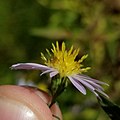| Symphyotrichum novi-belgii | |
|---|---|

| |
| Conservation status | |
 Secure (NatureServe) | |
| Scientific classification | |
| Kingdom: | Plantae |
| Clade: | Tracheophytes |
| Clade: | Angiosperms |
| Clade: | Eudicots |
| Clade: | Asterids |
| Order: | Asterales |
| Family: | Asteraceae |
| Tribe: | Astereae |
| Subtribe: | Symphyotrichinae |
| Genus: | Symphyotrichum |
| Subgenus: | Symphyotrichum subg. Symphyotrichum |
| Section: | Symphyotrichum sect. Symphyotrichum |
| Species: | S. novi-belgii |
| Binomial name | |
| Symphyotrichum novi-belgii (L.) G.L.Nesom | |
| Varieties | |
| List | |

| |
| Native distribution | |
| Synonyms | |
|
Basionym
| |
Symphyotrichum novi-belgii (formerly Aster novi-belgii), commonly called New York aster, is a species of flowering plant. It is the type species for Symphyotrichum, a genus in the family Asteraceae, whose species were once considered to be part of the genus Aster. Plants in both these genera are popularly known as Michaelmas daisy because they bloom around September 29, St. Michael’s Day.
The Latin specific epithet novi-belgii (literally "New Belgium") refers not to modern Belgium, but the 17th century Dutch colony New Netherland which was established on land currently occupied by New York state (as Belgica Foederata was the Latin term for the United Netherlands at the time).
Symphyotrichum novi-belgii grows in abandoned fields and wet meadows in eastern Canada and the northeastern United States.
Gallery
Distribution
New York aster is native to eastern Canada and the eastern United States.
Cultivation
This is the largest group of Michaelmas daisies, with over 1,000 named cultivars. They are valued for their late summer color in shades of blue, pink and white. They are best planted in an open, sunny position, and they are susceptible to fungal infections, especially if conditions are not ideal. The cultivars 'Coombe Fishacre' and 'Fellowship' have gained the Royal Horticultural Society's Award of Garden Merit.
Etymology
The Latin-derived specific epithet novi-belgii means "from New York", which was formerly named Novum Belgium ("New Belgium").
Citations
- NatureServe 2021.
- ^ POWO 2019.
- Brouillet et al. 2006.
- Harrison 2012.
- Royal Horticultural Society n.d.a.
- Royal Horticultural Society n.d.b.
- Gledhill 2008.
References
- Brouillet, L.; Semple, J.C.; Allen, G.A.; Chambers, K.L.; Sundberg, S.D. (2006). "Symphyotrichum novi-belgii". In Flora of North America Editorial Committee (ed.). Flora of North America North of Mexico (FNA). Vol. 20. New York and Oxford: Oxford University Press. Retrieved 18 July 2021 – via eFloras.
- Gledhill, D. (2008). The Names of Plants. Cambridge University Press. p. 275. ISBN 9780521866453.
- Harrison, L. (2012). RHS Latin for Gardeners. United Kingdom: Mitchell Beazley. ISBN 978-1845337315.
- NatureServe (2 July 2021). "Symphyotrichum novi-belgii Longleaf Aster". explorer.natureserve.org. Arlington, Virginia. Retrieved 18 July 2021.
- POWO (2019). "Symphyotrichum novi-belgii (L.) G.L.Nesom". www.plantsoftheworldonline.org. Royal Botanic Gardens, Kew. Retrieved 18 July 2021.
- Royal Horticultural Society (n.d.a). "RHS Plant Finder - Symphyotrichum 'Coombe Fishacre'". www.rhs.org.uk. London. Retrieved 5 March 2021.
- Royal Horticultural Society (n.d.b). "RHS Plant Finder - Symphyotrichum novi-belgii 'Fellowship'". www.rhs.org.uk. London. Retrieved 5 March 2021.





